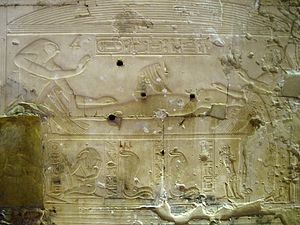- Myth of Osiris and Isis
-
The Myth of Osiris and Isis, concerning the deities of Egyptian mythology Osiris, Isis, Horus, and Set, became one of the most important and powerful in Egyptian mythology during the New Kingdom. The myth concerns the death of Osiris and the birth of Horus.
Contents
The coffin and 14 parts
The original form of the myth states that Osiris was killed by a wooden sarcophagus secretly being made to his measurements by Seth, who was jealous of Osiris's position as king, and so plotted to kill him and take his place. A party had been held where the coffin was offered to whoever could fit inside. A few people tried to fit in, but to no avail. Osiris was encouraged to try, but as soon as he lay back, the lid slammed on him and was locked. It was then sealed with lead and thrown into the Nile. Upon hearing that Osiris was gone, Isis set out to look for him. She was afraid that without proper ceremonies and burial Osiris would not be able to go to the place of the dead. She later learned that the coffin had floated down the Nile river up to the coast of Byblos (now in modern day Lebanon) and became embedded in the trunk of a cedar tree. She also learned that the cedar tree had been taken and used as a pillar to support a palace for the king of Byblos. When traveling back, along the Nile River, she left the coffin in an area of marshland. Seth, while hunting, finds Osiris' coffin and dismembered him into 14 parts, scattering them across the land of Egypt. Each part represented one of the 14 full moons (each year has 12 to 14 full moons).[1]
Once again Isis set out to look for the pieces and she was able to find 13 of the 14 parts, with the help of Nephthys, Seth's sister-wife, but was unable to find the 14th, as it had been eaten by a fish. Instead, she fashioned a phallus out of gold and sang a song around Osiris until he came back to life.
Osiris was resurrected. He could have proper ceremonies and burial.
Due to this experience, Osiris became Lord of the Dead, and the Afterlife. [2]
The moon and the oxyrhynchus
In late Egyptian thought, the righteous dead were sometimes said to become the stars, and thus the moon was occasionally seen as having a connection to Osiris, lord of the dead.[3] As a death and resurrection legend, in which evil seeks to destroy a deity, thus bringing darkness, it thus developed an association with the lunar cycle, in which the moon appears to be destroyed by darkness, and is then brought back to life. Thus it later became said that Osiris had been killed by being dismembered into 13 parts, each part representing one of the 13 full moons seen each year (there are roughly 13 lunar months per year). Another interpretation is that the pieces were 14 (they number up to sixteen in some versions) were the phases of a single moon's cycle (one sliver cut off each night for 14 days, then reassembled over the next 14 days—see Janet McCrickard, Eclipse of the Sun, 1990). The original form of Set's murder of Osiris was incorporated into this later version, though it was said that the attempt had failed when Isis and Nepthys found the coffin and rescued it.[citation needed]
Consequently, the story became that before resurrecting Osiris, Isis put together 13 of the 14 parts, but was unable to find the 14th, his phallus, which was eaten by the oxyrhynchus fish (a fish with an unusual curved snout resembling depictions of Set). So Isis created a phallus for him, and then attempted to revive him. In some versions, Isis sang a song around Osiris until he came back to life. She then took the form of a kite and flew around his body in order to conceive Horus. In other tellings of the story, Isis grows wings and hovers over Osiris. She breathes life into him in order to revive him and conceive Horus. Being simultaneously alive and dead, Osiris became the god and king of the afterlife.
Development and mystery
As a life-death-rebirth deity, Horus/Osiris became a reflection of the annual cycle of crop harvesting as well as reflecting people's desires for a successful afterlife, and so the legend became extremely important, outstripping all others. The legend's ventures into both life and afterlife meant that religious rites associated with the legend eventually began to take on aspects of a mystery religion, where initiates were said to be able to partake in Horus/Osiris' resurrection, purging themselves of past ills, and entering a new life.
In Greece, the Demeter-Persephone death-resurrection cult at Eleusis, had a similar nature, and began at approximately the same time. Many centuries later this led to interest in the Egyptian cult by the Greeks, including Plato. Eventually, a derived form of the Egyptian cult, having been infused with Platonism, spread to areas of Greek influence, particularly during the Hellenistic era of control over Egypt. As the cult referred to foreign gods, the forms of the cult in Greek nations were adopted to describe suitable local deities and merged and expanded to include elements from the local cultures. This produced a collection of closely related versions of the cult, whose central deities had been deformed to be similar to the Egyptian cult, and were by the 1st century BC collectively known as Osiris-Dionysus.[citation needed]
References
- ^ Dr. Irv Bromberg. "Ratio of Lunar Months per Solar Year". University of Toronto, Canada. http://individual.utoronto.ca/kalendis/solar/Atomic_Year_MSM_Ratios.pdf.
- ^ "Ancient Egypt", page 137 in chapter 10 by Dr. Robert K. Ritner. Oxford University Press, 1997.
- ^ "Ancient Egypt", page 137 in chapter 10 by Dr. Robert K. Ritner. Oxford University Press, 1997.
Categories:- Egyptian mythology
Wikimedia Foundation. 2010.

